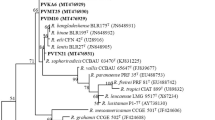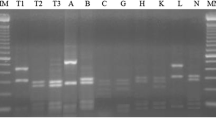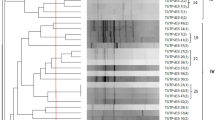Abstract
Background and Aims
This study was conducted to reveal the genetic diversity of common bean (Phaseolus vulgaris L.) nodulating rhizobia in various agroecological regions in Nepal.
Method
A total of 63 strains were isolated from common bean grown in the soils collected from seven bean fields in Nepal and characterized based on the partial sequences of 16S–23S internal transcribed spacer (ITS) regions, 16S rDNA, nodC, and nifH. Symbiotic properties of some representative strains with host plants were examined to elucidate their characteristics in relation to genotype and their origin.
Results
The isolated strains belonged to Rhizobium leguminosarum, Rhizobium etli, Rhizobium phaseoli, and one unknown Rhizobium lineage, all belonging to a common symbiovar (sv.) phaseoli. Nine ITS genotypes were detected mainly corresponding to a single site, including a dominant group at three sites harboring highly diverse multiple ITS sequences. Three symbiotic genotypes corresponded to a geographical region, not to the ribosomal DNA group, suggesting horizontal transfer of symbiotic genes separately in each region. Great differences in nitrogenase activity and nodule forming ability among the strains irrespective of their species and origin were observed.
Conclusions
Nepalese Himalaya harbor phylogenetically highly diverse and site-specific strains of common bean rhizobia, some of which could have high potential of symbiotic nitrogen fixation.






Similar content being viewed by others
References
Adhikari D, Kaneto M, Itoh K, Suyama K, Pokharel BB, Gaihre YK (2012) Genetic diversity of soybean-nodulating rhizobia in Nepal in relation to climate and soil properties. Plant Soil 357:131–145
Aguilar OM, Lopez MV, Riccillo PM, Gonzalez RA, Pagano M, Grasso DH, Puhler A, Favelukes G (1998) Prevalence of the Rhizobium etli-like allele in genes coding for 16S rRNA among the indigenous rhizobial populations found associated with wild beans from the Southern Andes in Argentina. Appl Environ Microbiol 64:3520–3524
Aguilar OM, Riva O, Peltzer E (2004) Analysis of Rhizobium etli and of its symbiosis with wild Phaseolus vulgaris supports coevolution in centers of host diversification. Proc Natl Acad Sci USA 101:13548–13553
Aguilar OM, Lopez MV, Donato M, Moron B, Soria-Diaz ME, Mateos C, Gil-Serrano A, Sousa C, Megias M (2006) Phylogeny and nodulation signal molecule of rhizobial populations able to nodulate common beans—other than the predominant species Rhizobium etli—present in soils from the northwest of Argentina. Soil Biol Biochem 38:573–586
Altschul SF, Madden TL, Schaffer AA, Zhang J, Zhang Z, Miller W, Lipman DJ (1997) Gapped BLAST and PSI-BLAST: a new generation of protein database search programs. Nucleic Acids Res 25:3389–3402
Amarger N, Macheret V, Laguerre G (1997) Rhizobium gallicum sp. nov. and Rhizobium giardinii sp. nov., from Phaseolus vulgaris Nodules. Int J Syst Bacteriol 47:996–1006
Andrade DS, Murphy PJ, Giller KE (2002) The diversity of Phaseolus-nodulating rhizobial populations is altered by liming of acid soils planted with Phaseolus vulgaris L. in Brazil. Appl Environ Microbiol 68:4025–4034
Anyango B, Wilson KJ, Beynon JL, Giller KE (1995) Diversity of rhizobia nodulating Phaseolus vulgaris L. in two Kenyan soils with contrasting pHs. Appl Environ Microbiol 61:4016–4021
Aragao FL, Brondani RPV, Burle ML (2011) Chapter 11: Phaseolus. In: Kole C (ed) Wild crop relatives: genomic and breeding resources, Legume Crops and Forages. Springer, Berlin, pp 223–236
Aserse AA, Rasanen LA, Assefa F, Hailemariam A, Lindstorm K (2012) Phylogeny and genetic diversity of native rhizobia nodulating common bean (Phaseolus vulgaris L.) in Ethiopia. Syst Appl Microbiol 35:120–131
Beyene D, Kassa S, Ampy F, Asseffa A, Gebremedhin T, van Berkum P (2004) Ethiopian soils harbor natural populations of rhizobia that form symbioses with common bean (Phaseolus vulgaris L.). Arch Microbiol 181:129–136
Caballero-Mellado J, Martinez-Romero E (1999) Soil fertilization limits the genetic diversity of Rhizobium in bean nodules. Symbiosis 26:111–121
Cervantes L, Bustos P, Girard L, Santamaría RI, Davila G, Vinuesa P, Romero D, Brom S (2011) The conjugative plasmid of a bean-nodulating Sinorhizobium fredii strain is assembled from sequences of two Rhizobium plasmids and the chromosome of a Sinorhizobium strain. BMC Microbiol 11:149
Daffonchio D, Cherif A, Borin S (2003) Homoduplex and heteroduplex polymorphisms of the amplified ribosomal 16S-23S internal transcribed spacers describe genetic relationships in the “Bacillus cereus group”. Appl Environ Microbiol 66:5460–5468
Fahraeus G (1959) The infection of clover root hairs by nodule bacteria studied by a simple glass slide technique. J Gen Microbiol 16:374–381
Garcia-Fraile P, Mulas-Garcia D, Peix A, Rivas R, Gonzalez-Andres F, Velazquez E (2010) Phaseolus vulgaris is nodulated in northern Spain by Rhizobium leguminosarum strains harboring two nodC alleles present in American Rhizobium etli strains: biogeographical and evolutionary implications. Can J Microbiol 56:657–666
Graham PH, Ranalli P (1997) Common bean (Phaseolus vulgaris L.). Field Crops Res 53:131–146
Herrera-Cervera JA, Caballero-Mellado J, Laguerre G, Tichy HV, Requena N, Amarger N, Martinez-Romero E, Olivares J, Sanjuan J (1999) At least five rhizobial species nodulate Phaseolus vulgaris in a Spanish soil. FEMS Microbiol Ecol 30:87–97
Hiraishi A, Inagaki K, Tanimoto Y, Iwasaki M, Kishimoto N, Tanaka H (1997) Phylogenetic characterization of a new thermoacidophilic bacterium isolated from hot springs in Japan. J Gen Appl Microbiol 43:295–304
Isoi T, Yoshida S (1991) Low nitrogen fixation of common bean (Phaseolus vulgaris L.). Soil Sci Plant Nutr 37:550–563
Kundig C, Beck C, Hennecke H, Gottfert M (1995) Single rRNA gene in Bradyrhizobium japonicum. J Bacteriol 177:5151–5154
Laguerre G, Allard MR, Revoy F, Amarger M (1994) Rapid identification of rhizobia by restriction fragment length polymorphism analysis of PCR amplified 16S rRNA genes. Appl Environ Microbiol 60:56–63
Lopez-Guerrero MG, Ormeno-Orrillo E, Velazquez E, Rogel MA, Acosta JL, Gonzalez V, Martinez J, Martinez-Romero E (2012) Rhizobium etli taxonomy revised with novel genomic data and analyses. Syst Appl Microbiol 35:353–358
Mehlich A (1984) Mehlich 3 soil test extractant: a modification of Mehlich 2 extractant. Comm Soil Sci Plant Anal 15:1409–1416
Mhamdi R, Jebara M, Aouani ME, Ghrir R, Mars M (1999) Genotypic diversity and symbiotic effectiveness of rhizobia isolated from roots nodules of Phaseolus vulgaris L., grown in Tunisian soils. Biol Fertil Soils 28:313–320
Mnasri B, Mrabet M, Laguerre G, Aouani ME, Mhamdi R (2007) Salt-tolerant rhizobia isolated from a Tunisian oasis that are highly effective for symbiotic N2-fixation with Phaseolus vulgaris constitute a novel biovar (bv. mediterranense) of Sinorhizobium meliloti. Arch Microbiol 187:79–85
Mulas D, Gracia-Fraile P, Carro L, Ramirez-Bahena MH, Casquero P, Velazquez E, Gonzalez-Andres F (2011) Distribution and efficiency of Rhizobium leguminosarum strains nodulating Phaseolus vulgaris in Northern Spanish soils: selection of native strains that replace conventional N fertilization. Soil Biol Biochem 43:2283–2293
Perez-Ramirez NO, Rogel MA, Wang E, Castellanos JZ, Martinez-Romero E (1998) Seeds of Phaseolus vulgaris bean carry Rhizobium etli. FEMS Microbiol Ecol 26:289–296
Ramirez-Bahena MH, Garcia-Fraile P, Peix A, Valverde A, Rivas R, Igual JM, Mateos PF, Martinez-Molina E, Velazquez E (2008) Revision of the taxonomic status of the species Rhizobium leguminosarum (Frank 1879) Frank 1889AL, R. phaseoli Dangeard 1926AL and R. trifolii Dangeard 1926AL. R. trifolii is a later synonym of R. leguminosarum. Reclassification of the strain Rhizobium leguminosarum DSM 30132T (=NCIMB 11478T) into the new species Rhizobium pisi sp. nov. Int J Syst Evol Microbiol 58:2484–2490
Ribeiro RA, Rogel MA, Lopez-Lopez A, Ormeno-Orrillo E, Barcellos FG, Martinez J, Thompson FL, Martínez-Romero E, Hungria M (2012) Reclassification of Rhizobium tropici type A strains as Rhizobium leucaenae sp. nov. Int J Syst Evol Microbiol 62:1169–1184
Rivas R, Velazquez E, Willems A, Vizcaino N, Subba-Rao NS, Mateos PF, Gillis M, Dazzo FB, Martinez-Molina E (2002) A new species of Devosia that forms a nitrogen-fixing root-nodule symbiosis with the aquatic legume Neptunia natans (L. f.) Druce. Appl Environ Microbiol 68:5217–5222
Rodriguez-Navarro DN, Buendia AM, Camacho M, Lucas MM, Santamaria C (2000) Characterization of Rhizobium spp. bean isolates from South-West Spain. Soil Biol Biochem 32:1601–1613
Rogel MA, Ormeno-Orrillo E, Martinez-Romero E (2011) Symbiovars in rhizobia reflect bacterial adaptation to legumes. Syst Appl Microbiol 34:96–104
Segovia L, Young JPW, Martinez-Romero E (1993) Reclassification of American Rhizobium leguminosarum biovar phaseoli type I strains as Rhizobium etli sp. nov. Int J Syst Evol Microbiol 43:374–377
Sessitsch A, Hardarson G, Akkermans ADL, de Vos WM (1997) Characterization of Rhizobium etli and Rhizobium spp. that nodulate Phaseolus vulgaris L. in an Austrian soil. Mol Ecol 6:601–608
Shamseldin AAY, Vinuesa P, Thierfelder H, Werner D (2005) Rhizobium etli and Rhizobium gallicum Nodulate Phaseolus vulgaris in Egyptian soils and display cultivar-dependent symbiotic efficiency. Symbiosis 38:145–161
Silva C, Eguiarte LE, Martinez-Romero E, Souza V (2003) Rhizobium etli and Rhizobium gallicum nodulate common bean (Phaseolus vulgaris) in a traditionally managed milpa plot in Mexico: population genetics and implications. Appl Environ Microbiol 69:884–893
Someya T, Wang X, Gong C, Koshida K, Hakagawa H, Tanaka C, Ishibashi M, Yokobori K, Inoue K (2003) Rapid and specific detection and enumeration of microorganisms in soil and manure. Soil Microorg 57:115–123
Souza V, Eguiarte L, Avila G, Cappello R, Gallardo C, Montoya J, Pinero D (1994) Genetic structure of Rhizobium etli biovar phaseoli associated with wild and cultivated bean plants (Phaseolus vulgaris and Phaseolus coccineus) in Morelos, Mexico. Appl Environ Microbiol 60:1260–1268
Tamimi SM, Young JPW (2004) Rhizobium etli is the dominant common bean nodulating rhizobia in cultivated soils from different locations in Jordan. Appl Soil Ecol 26:193–200
Tan Z, Hurek T, Vinuesa P, Muller P, Ladha JK, Reinhold-Hurek B (2001) Specific detection of Bradyrhizobium and Rhizobium strains colonizing rice (Oryza sativa) roots by 16S-23S ribosomal DNA intergenic spacer-targeted PCR. Appl Environ Microbiol 67:3655–3664
Thompson JD, Higgins DG, Gibson TJ (1994) CLUSTAL W: improving the sensitivity of progressive multiple sequence alignment through sequence weighting, position-specific gap penalties and weight matrix choice. Nucleic Acids Res 22:4673–4680
van Berkum P, Beyene D, Eardly BD (1996) Phylogenetic relationships among Rhizobium species nodulating the common bean (Phaseolus vulgaris L.). Int J Syst Bacteriol 46:240–244
Vincent JM (1970) A manual for the practical study of root nodule bacteria. IBP Handbook No. 15. Blackwell, Oxford
Weisburg WG, Barns SM, Pelletier DA, Lane DJ (1991) 16S ribosomal DNA amplification for phylogenetic study. J Bacteriol 173:697–703
Author information
Authors and Affiliations
Corresponding author
Additional information
Responsible Editor: Euan K. James.
Rights and permissions
About this article
Cite this article
Adhikari, D., Itoh, K. & Suyama, K. Genetic diversity of common bean (Phaseolus vulgaris L.) nodulating rhizobia in Nepal. Plant Soil 368, 341–353 (2013). https://doi.org/10.1007/s11104-012-1518-7
Received:
Accepted:
Published:
Issue Date:
DOI: https://doi.org/10.1007/s11104-012-1518-7




